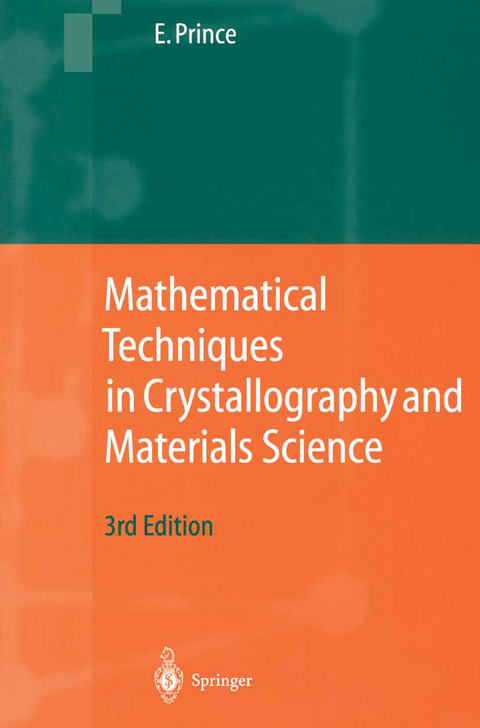
Mathematical Techniques in Crystallography and Materials Science
Springer Berlin (Verlag)
978-3-540-21111-2 (ISBN)
Kristallographen finden in diesem Buch die Information und die Daten, die sie für ihre tägliche Arbeit brauchen. Der Autor hat es als Vademecum geschrieben. Die zweite Auflage wurde vollständig überarbeitet und um zwei Kapitel mit neueren Methoden erweitert.
Crystallographers have to apply many mathematical methods in their daily work. Mathematical Techniques in Crystallography and Materials Science brings together common and less familiar mathematical procedures used in studies of the structures and physical properties of solids. This practical guide and reference serves as a unified source book for students and professionals, and it provides a solid basis for further studies in more specialized literature. Based Prince's decades of practical experience, it can be recommended as an introduction for beginners in crystallography, as a refresher and handy guide for crystallographers working on specific problems, and as a reference for others seeking a dictionary of basic mathematical and crystallographic terms. The third edition further clarifies key points, as well as offers new sections on two topics: the projection matrix and the fast Fourier transform.
Crystallographers have to apply many mathematical methods in their daily work. Mathematical Techniques in Crystallography and Materials Science brings together common and less familiar mathematical procedures used in studies of the structures and physical properties of solids. This practical guide and reference serves as a unified source book for students and professionals, and it provides a solid basis for further studies in more specialized literature. Based Prince's decades of practical experience, it can be recommended as an introduction for beginners in crystallography, as a refresher and handy guide for crystallographers working on specific problems, and as a reference for others seeking a dictionary of basic mathematical and crystallographic terms. The third edition further clarifies key points.
1 Matrices: Definitions and Fundamental Operations.- Fundamental Matrix Operations.- Linear Algebra.- Eigenvalues.- Linear Transformations.- Rotation of Axes.- The Metric Tensor.- 2 Symmetry of Finite Objects.- Groups.- Representations.- Point Groups.- Basis Functions.- 3 Symmetry of Infinitely Repeated Patterns.- Bravais Lattices.- Space Groups.- 4 Vectors.- Scalar and Vector Products.- The Reciprocal Lattice.- The Orientation Matrix.- Zones and Forms.- Sublattices and Superlattices.- 5 Tensors.- Covariance and Contravariance.- The Multivariate Normal Disribution.- Anisotropic Atomic Displacement Factors.- The Equivalent Isotropic Temperature Factor.- Effect of Symmetry.- Tensors of Higher Ranks.- Moments and Cumulants.- Rigid Body Motion.- 6 Data Fitting.- Fitting Functions.- Finding the Minimum.- False Minima.- 7 Estimation of Uncertainty.- Estimates.- The Precision of Estimates of Precision.- Models with More than One Parameter.- Estimates of Precision When the Model Is Not Least Squares.- 8 Significance and Accuracy.- The F Distribution.- Student's t Distribution.- Correlation.- Relationship Between Precision and Accuracy.- Uncertainties of Derived Functions.- The Projection Matrix.- 9 Constrained Crystal Structure Refinement.- The Observed Data.- The Model.- The General Form for a Constrained Model.- Shape Constraints.- Rigid Body Thermal Motion Constraints.- Chemical Constraints.- Representing non-Gaussian Distributions.- 10 The Fast Fourier Transform.- The Discrete Fourier Transform.- The Good-Thomas Algorithm.- The Cooley-Tukey Algorithm.- Prime Numbers.- FFTs for Real Sequences.- Space Group Symmetry.- Appendix A Stereographic Projection.- Appendix B Eigenvalues and Eigenvectors of 3 × 3 Symmetric Matrices.- Appendix C Sublattices and Superlattices.-Appendix D The Probability Integral, the Gamma Function, and Related Topics.- Appendix E The Harmonic Oscillator in Quantum Mechanics: Bloch's Theorem.- Appendix F Symmetry Restrictions on Second, Third, and Fourth Rank Tensors.- Appendix G Some Useful Computer Programs.- ndex.
From the reviews of the third edition:
"Mathematical Techniques in Crystallography and Material Science brings together common and less familiar mathematical procedures used in studies of the structures and physical properties of solids. This practical guide and reference serves as a unified source book for students and professionals, and it provides a solid basis for further studies in more specialized literature. Based Prince's decades of practical experience, it can be recommended as an introduction for beginners in crystallography, as a refresher and handy guide for crystallographers working on specific problems ... ." (Chimie Nouvelle Societe, Vol. 23 (89), 2005)
"This book presents a series of mathematical methods and procedures ... . The material is well set out ... . In a refreshing approach, the references are introduced with a historical flavour. ... This type of book would be particularly useful for students and professionals who are new to crystallography. It would also be a handy guide to materials scientists ... . this book generally fulfils its aims as a practical guide and reference to students and professionals in the field of crystallography." (Dougal McCulloch, Chemistry in Australia, November, 2004)
| Erscheint lt. Verlag | 23.3.2004 |
|---|---|
| Zusatzinfo | XII, 224 p. |
| Verlagsort | Berlin |
| Sprache | englisch |
| Maße | 155 x 235 mm |
| Gewicht | 370 g |
| Themenwelt | Naturwissenschaften ► Chemie ► Physikalische Chemie |
| Schlagworte | algorithm • crystallography • Kristallographie • linear algebra • Materialwissenschaft • Mathematical Methods • mathematische Methoden • Mechanics • Model • quantum mechanics • Transformation |
| ISBN-10 | 3-540-21111-X / 354021111X |
| ISBN-13 | 978-3-540-21111-2 / 9783540211112 |
| Zustand | Neuware |
| Haben Sie eine Frage zum Produkt? |
aus dem Bereich


